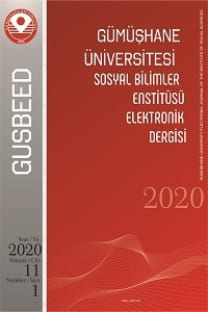Dış Borç ve Ekonomik Büyüme Arasındaki İlişki: Kırılgan Beşli Ülkeleri Örneği
Dış borçlanma, Ekonomik büyüme, VAR analizi, Granger nedenselliği
The Relationship Between External Debt and Economic Growth: The Case of Fragile Five Countries
External borrowing, Economic growth, VAR analysis, Granger causality,
___
Awan, R. U., Anjum, A. & Rahim, S. (2015). An econometric analysis of determinants of external debt in Pakistan. British Journal of Economics, Management & Trade, 5(4): 382-391.Chaudhry, I. S., Iffat, S. & Farooq, F. (2017). Foreign direct investment, external debt and economic growth: Evidence from some selected developing countries. Review of Economics and Development Studies,3(2): 111-124.
Checherita, C. & Rother, P. (2010). The impact of high and growing gowernment debt on economic growth an empirical investigation for the Euro area. European Central Bank Working Paper Series, No:1237: 1-42.
Clements, B., Bhattacharya, R. & Nguyen, T. Q. (2003). External debt, public investment, and growth in low-income countries. IMF Working Paper, WP/03/249: 1-20.
Çöğürcü, İ. ve Çoban, O. (2011). Dış borç büyüme ilişkisi: Türkiye örneği (1980-2009). KMÜ Sosyal ve Ekonomik Araştırmalar Dergisi, 13(21): 133-149.
Darnell, A. C. (1990). Dictionary of econometrics. London: Edward Elgar Publishing.
Dickey, D. A. & Fuller, W. (1979). Distribution of the estimators for autoregressive time series with a unit root., Journal of the American Statistical Association, 74(366): 427-431.
Dornbusch, R., Fischer, S. & Startz, R. (1998). Macroeconomics. Seventh Edition, McGraw-Hill Companies.
Fosu, A. K. (2011). The external debt burden and economic growth in the 1980s: Evidence from Sub-Saharan Africa. Canadian Journal of Development Studies, 20(2): 307-318.
Froot, K. A. (1988). Buybacks, exit bonds, and the optimality of debt and liquidity relief. NBER Working Paper, 2675: 1-33.
Granger, C. W. J. (1969). Investigating causal relations by econometric models and cross-spectral methods. Econometrica, 37(3): 424-438.
Granger, C. W. J. & Newbold, P. (1977). Forecasting economic time series, New York: Academic Press.
Greene, W. H. (1997). Econometric analysis, 3rd Edition, New Jersey: Prentice Hall Internation.
Gürdal, T. ve Yavuz, H. (2015). Türkiye’de dış borçlanma-ekonomik büyüme ilişkisi:1990-2013 dönemi. Maliye Dergisi, 168: 154-169.
Hoffman, B. & Reisen, H. (1991). Some evidence on debt-related determinants on investment and consumption in heavily indebted countries. Weltwirschafiliches Archiv, 127(2): 280-297.
Iyoha, M. A. (1999). External debt and economic growth in Sub-Saharan African countries: An econometric study. AERC Research Paper, No:90, Nairobi, African Economic Research Consortium: 1-59.
Juselius, K. (2006). The cointegrated VAR model - Methodology and applications. Oxford University Press.
Krugman, P. (1988). Financing vs. forgiving a debt overhang: Some analytical notes. Journal of Development Economics, 29: 253-268.
Lütkepohl, H. (2004). Applied time series econometrics. Cambridge: Cambridge University Press.
Mohd Daud, S. N. & Podivinsky, J. M. (2012). Revisiting the role of external debt in economic growth of developing countries. Journal of Business Economics and Management, 13(5): 968–993.
Morgan Stanley. (2013). Tales from the emerging world. [Available online at: https://www.morganstanley.com/public /Tales_from_the_Emerging_World_Fragile_Five.pdf], Retrieved on December 13, 2018.
Nurkse, R. (1971). The theory of development and the idea of balanced growth. In A. B. Mountjoy (Eds.), Developing the underdeveloped countries (pp. 115-128). London: Palgrave Macmillan.
Okon, E. O. & Monday, O. I. (2017). Empirical and evidence-based investigation: External debt, poverty and economic growth nexus. International Journal of Applied Economics, Finance and Accounting, 1(1): 37-47.
Pattillo, C., Poirson, H. & Ricci, L. (2002). External debt and growth. IMF Working Paper, WP/02/69: 1-49.
Reinhart, C. M. & Rogoff, K. S. (2010). Growth in a time of debt. The American Economic Review, 100(2): 573-578.
Sims, C. A. (1980). Macroeconomics and reality. Econometrica, 48(1), 1-48.
Sims, C. A. (1972). Money, income and causality. The American Economic Review, 62(4): 540-552.
Warne, A. (2000) Lecture notes on structural vector autoregression. [Available online at: http:// texlips.hypermart.net/ download/lecture_notes.pdf] Retrieved on April 18, 2017.
- ISSN: 1309-7423
- Yayın Aralığı: Yılda 3 Sayı
- Yayıncı: Gümüşhane Üniversitesi
Enflasyondan Korunma Aracı Olarak Altın Yatırımı
Ekonomi Eğitiminin Ekonomi Okuryazarlık Düzeyine Etkisinin Belirlenmesi Üzerine Bir Araştırma
Mükellef Memnuniyetinin İdari Yönden Yapısal Eşitlik Modeli ile Analizi
Öğretmen Adaylarının Öğrenme Ortamına Web 2.0 Teknolojilerini Entegre Edebilme Yeterliliği
Necla DÖNMEZ USTA, Ebru TURAN GÜNTEPE, Ümmü Gülsüm DURUKAN
Yalnızlık Ölçeğinin Okullar için Türkçe Uyarlaması
Öğretmen Adaylarının Teknoloji Yeterlilikleri ile Teknolojiye Bakış Açısı Arasındaki İlişki
Mustafa AKSOĞAN, Muzeyyen BULUT ÖZEK
İhracat Performansı ile İşletmelerin Girişimcilik Özellikleri İlişkisi: Türkiye Örneği
Metehan ORTAKARPUZ, Ömer AYDIN
UNESCO Adayı Mahmutbey Cami’ne Gelen Ziyaretçilerin Camiye ve Şehre Yönelik Algı ve Memnuniyetleri
Elif Nur İrem DURMUŞ, Canan TANRISEVER, Hüseyin PAMUKÇU
Kredi Kartı Kullanımını Etkileyen Faktörlerin Analizi: Doğu Karadeniz Örneği
Dilara AYLA, Önder DİLEK, Abdulmuttalip PİLATİN, Akif Ziya BAYRAK
